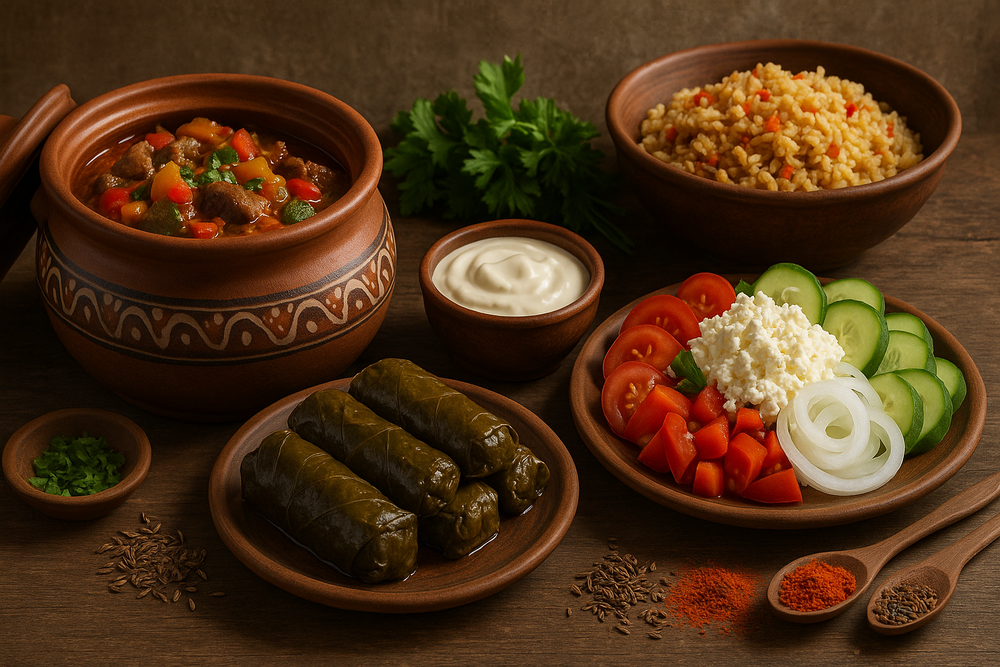
Melting Pot of Flavors: How Bulgaria’s Cuisine Blends East and West
Nestled at the crossroads of Europe and Asia, Bulgaria has long served as a cultural and culinary bridge between East and West. Its cuisine is a vivid reflection of this historical role, blending Slavic heartiness, Ottoman richness, and Mediterranean freshness into a unique gastronomic identity. Bulgarian food is not just about nourishing the body—it’s a celebration of centuries of cultural exchange, regional traditions, and the flavors that define a nation.
Slavic Roots and Rural Traditions
At its core, Bulgarian cuisine carries the comforting essence of its Slavic roots. Hearty stews, dairy-rich dishes, and robust grains dominate the table. Yogurt, known locally as “kiselo mlyako,” is a national pride and a staple in everyday meals. Its origins stretch back thousands of years and are deeply tied to the rural lifestyle. Another Slavic influence is the love for fermented foods—pickled vegetables, sauerkraut, and brined cheese, like the beloved white brine cheese “sirene,” are common across households.
Ottoman Legacy in the Kitchen
Five centuries under Ottoman rule left a lasting mark on the Bulgarian culinary landscape. The result is an array of flavorful dishes that showcase spices, slow-cooking techniques, and shared ingredients. One iconic example is gyuvech, a slow-cooked stew named after the clay pot it’s traditionally prepared in. This dish, often made with lamb or beef, vegetables, and paprika, bears unmistakable Turkish influences in both preparation and flavor.
The use of spices like cumin, cinnamon, and paprika, introduced via Ottoman trade routes, added depth to Bulgarian dishes. While Bulgarian food is milder than its Middle Eastern cousins, these spices are used sparingly to enhance rather than overpower.
Mediterranean Touches and Greek Influence
To the south, Greece has shaped Bulgaria’s palate with its coastal Mediterranean flavors. Olive oil, fresh herbs like oregano and mint, and an emphasis on seasonal produce reflect this influence. A perfect example is sarma—grape leaves stuffed with rice, herbs, and sometimes minced meat. While sarma is found across the Balkans, the Bulgarian version often combines Greek technique with local seasoning and yogurt-based sauces.
Salads also reveal this Mediterranean touch. The Shopska salad, made with tomatoes, cucumbers, onions, peppers, and grated sirene cheese, is a national dish that celebrates freshness, simplicity, and regional produce—hallmarks of Mediterranean cuisine.
The Trade Routes That Brought the World to Bulgaria
Bulgaria’s central location made it a stop along ancient trade routes, allowing ingredients and techniques from far-flung places to reach its kitchens. Paprika, now essential in countless dishes, came from the Americas via the Ottoman Empire. Similarly, rice and spices like black pepper and cumin journeyed along Silk Road paths to find a permanent place in local recipes.
Conclusion: A Flavorful Identity
Bulgarian cuisine is more than just a collection of dishes—it’s a reflection of history, geography, and resilience. By weaving together Slavic, Ottoman, and Mediterranean threads, Bulgaria has created a food culture that is both diverse and deeply personal. Whether you’re enjoying a clay pot gyuvech, a tangy sarma, or a fresh Shopska salad, each bite tells a story of lands and peoples that have shared not just borders, but flavors.











